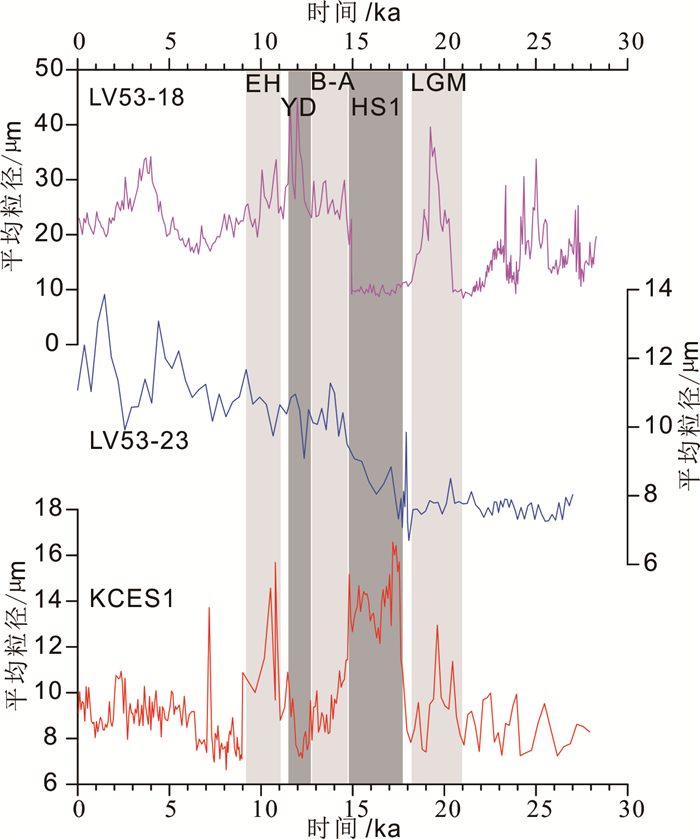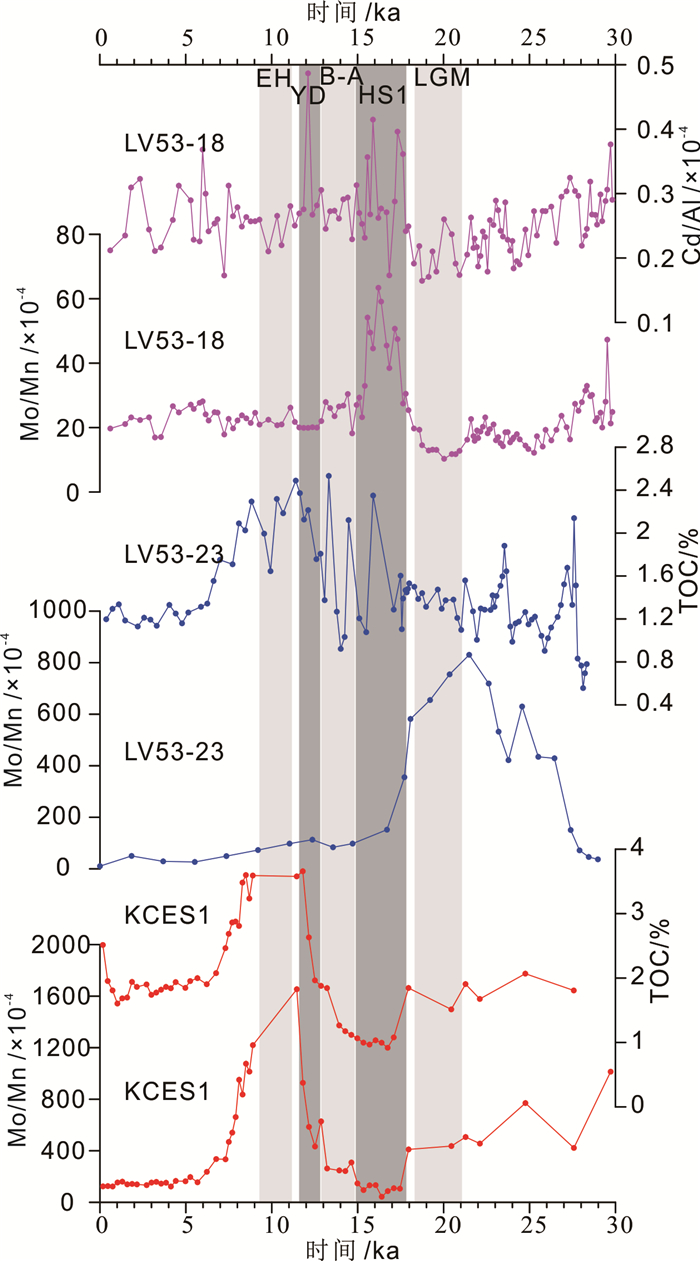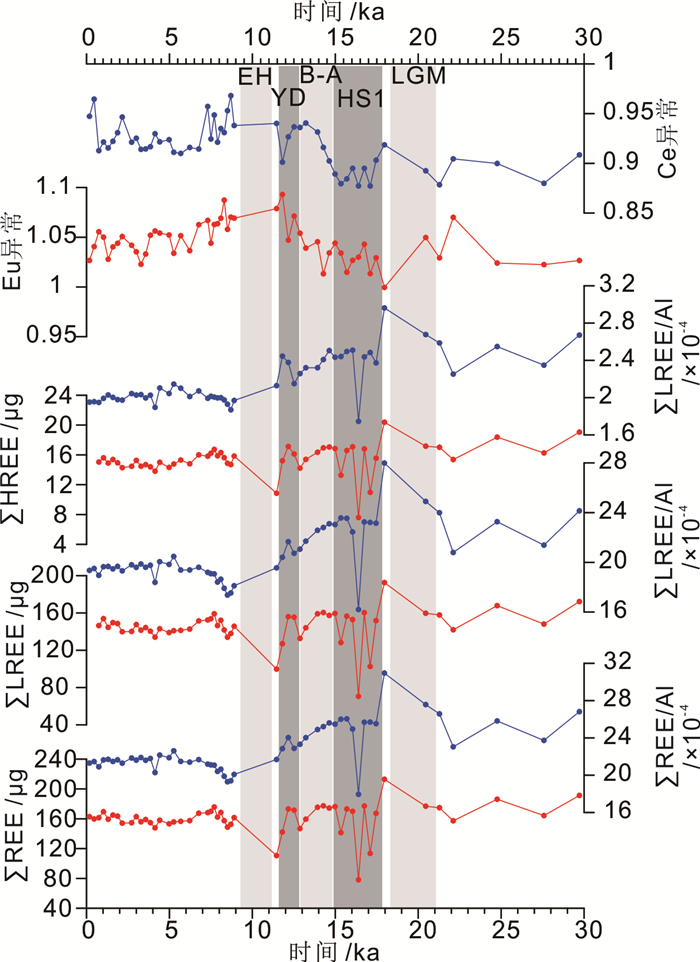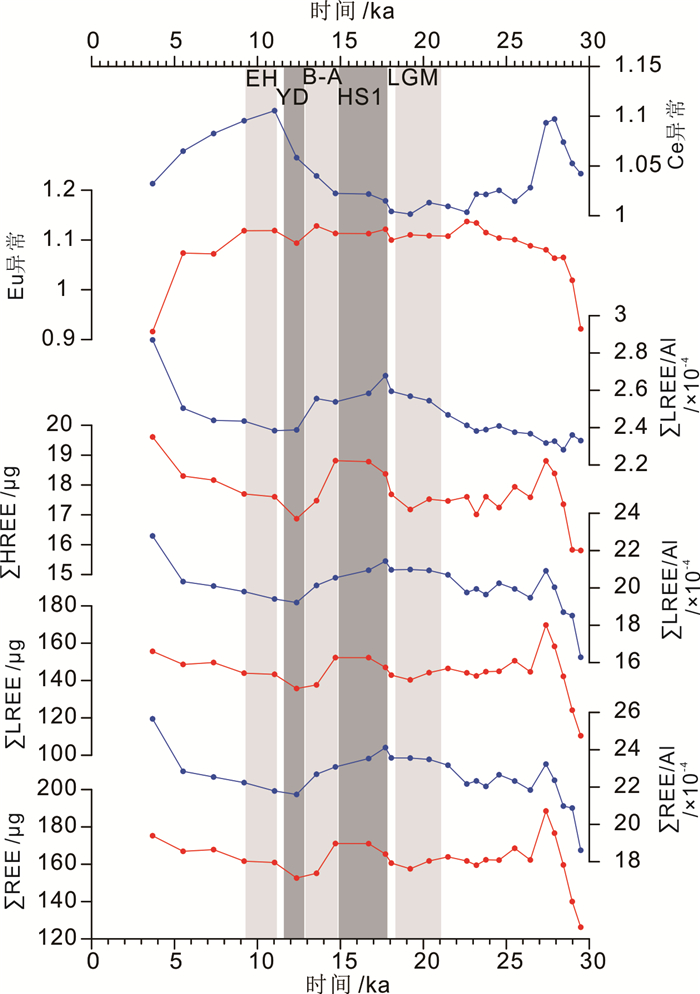Sedimentation and environment evolution of the Sea of Japan since the Last Glaciation and its driving forces
-
摘要:
基于对日本海南部、中部和西部3个沉积岩芯的综合研究,探讨了末次冰期以来日本海不同区域的沉积作用、环境演化特征及其控制因素。结果发现:在距今8ka以前,日本海南部、中部和西部陆源碎屑物质分别由河流物质、西风携带的风尘物质和海冰输运的物质组成;8ka以来日本海西部沉积物中存在连续分布的火山物质,推测与利曼寒流形成有关,标志着现代日本海表层环流格局的形成。在末次冰期,日本海中部和南部因为水体层化较强,导致底层水通风较弱,而日本海西部则由于盐析作用,通风较强。在冰消期早期,随着海平面上升,东海北部高盐水团再次入侵日本海,改善了日本海深层水体通风条件,但在日本海西部因受到常年海冰覆盖的影响,沉积物氧含量显著减小;在冰消期晚期和早全新世,日本海南部深层水体通风减弱,而在日本海中部和西部通风较好;但8ka以来日本海通风普遍增强。日本海的沉积作用和环境演化受海平面、东亚季风(西风环流)和对马暖流控制,但不同海域对上述3个因子的响应程度存在差异。海平面变化是控制日本海环境变化的首要因子,它直接制约着日本海与周围水体的交换程度;东亚夏季风影响日本海表层水体层化,而东亚冬季风则控制着日本海西部海冰的形成和深层水体垂向对流;8ka以来对马暖流成为控制日本海环境演化的重要因子,它的入侵增强了表层和底层水体交换,提高了日本海深层水体和沉积物溶解氧的更新速率。
Abstract:Sedimentation processes, environmental variations and driving mechanisms of the Sea of Japan since the Last Glaciation are discussed in this paper on the basis of a comprehensive study of three sediment cores retrieved from the southern, central and western parts of the Sea of Japan. The main findings are as follows. (1) Before 8 ka, terrigenous materials in the southern, central and western parts of the Sea of Japan were mainly coming from rivers, westerly wind and sea ice, respectively. The continuous distribution of volcanic materials in the sediments of the western Sea of Japan since 8 ka is probably related to the formation of the Liman Cold Current, which marks the formation of modern surface circulation pattern of the Sea of Japan. (2) The variations in ventilation characterized by oxygen-depletion in the south and central owe its origin to the strong surface stratification, while well-ventilated condition in the western Sea of Japan related to the active winter sea ice formation. With the eustatic sea level rising after the Last Glacial Maximum, cold and salty waters from the northern East China Sea intruded into the Sea of Japan through the Tsushima Strait during the Heinrich Stadial 1, that facilitate the deep ventilation in the south and central Sea of Japan. However, due to the perennial sea ice cover at the western part of the Sea of Japan, the sedimentary oxygenation declined significantly. During the Late Deglaciation and earlier Holocene, the deep ventilation of the Sea of Japan was dampened in the south but well maintained in the central and west. Generally, the deep ventilation in the entire Sea of Japan has been ameliorated since 8 ka due to the invasion of the high-salinity Tsushima Warm Current. Main driving factors controlling the sedimentary processes and environmental changes in the Sea of Japan are sea level changes, East Asian monsoon (and the westerly wind) and the Tsushima Warm Current, but the responses to the three factors are distinct from place to place. Sea level is the first-order factor that constraints the water exchange between the Sea of Japan and surrounding sea waters. The East Asian summer monsoon brings large amounts of freshwater to the Sea of Japan, while the East Asian winter monsoon controls the sea ice formation and thus the deep water convection. Since 8ka, the Tsushima Warm Current, a more important determinant factor, intruded into the Sea of Japan, which enhanced the exchange between surface and deep waters and thus the renewal rate of oxygen in the deep water and sediments.
-
Key words:
- sedimentation /
- environmental evolution /
- driving mechanisms /
- the last glaciation /
- Sea of Japan
-

-
[1] Wang P X. Response of western Pacific marginal seas to glacial cycles: paleoceanographic and sedimentological features[J]. Marine Geology, 1999, 156(1-4):5-39. doi: 10.1016/S0025-3227(98)00172-8
[2] Tada R. Paleoceanographic evolution of the Japan Sea[J]. Palaeogeography, Palaeoclimatology, Palaeoecology, 1994, 108(3-4):487-508. doi: 10.1016/0031-0182(94)90248-8
[3] Tada R, Murray R W, Alvarez Zarikian C A, et al. Proc. IODP, 346[C]. College Station, TX, United States: IODP Management International, 2015.
[4] Tamaki K, Pisciotto K A, Allan J, et al. Proc. ODP, Init. Repts., 127[C]. Vol. 127 College Station, TX (Ocean Drilling Program): ODP Management International, 1990.
[5] Bouma A H. Sedimentary structures of Philippine Sea and Sea of Japan sediments, DSDP Leg 31[J]. Initial Reports of the Deep Sea Drilling Project, 1975, 31:471.
[6] Tada R, Oba T, Jordan R W. Quaternary paleoceanography of the Japan Sea and its linkage with Asian Monsoon[J]. Palaeogeography, Palaeoclimatology, Palaeoecology, 2007, 247(1-2):1-4. doi: 10.1016/j.palaeo.2006.11.017
[7] Oba T, M. K, H. K, et al. Paleoenvironmental changes in the Japan Sea during the last 85000 years[J]. Paleoceanography, 1991, 6(4):499-518. doi: 10.1029/91PA00560
[8] Tada R, Irino T, Ikehara K, et al. High-resolution and high-precision correlation of dark and light layers in the Quaternary hemipelagic sediments of the Japan Sea recovered during IODP Expedition 346[J]. Progress in Earth and Planetary Science, 2018, 5(1):19, doi:10.1186/s40645-40018-40167-40648.
[9] Tada R. Onset and evolution of millennial-scale variability in the Asian monsoon and its impact on paleoceanography of the Japan Sea[J]. Continent-Ocean Interactions within East Asian Marginal Seas, 2004, 149:283-298. doi: 10.1029/GM149
[10] Nagashima K, Tada R, Tani A, et al. Contribution of aeolian dust in Japan Sea sediments estimated from ESR signal intensity and crystallinity of quartz[J]. Geochemistry Geophysics Geosystems, 2007, 8(2):13, doi:10.1029/2006gc001364.
[11] Zou J, Shi X, Liu Y, et al. Reconstruction of environmental changes using a multi-proxy approach in the Ulleung Basin (Sea of Japan) over the last 48 ka[J]. Journal of Quaternary Science, 2012, 27(9):891-900. doi: 10.1002/jqs.v27.9
[12] Yao Z, Liu Y, Shi X, et al. Paleoenvironmental changes in the East/Japan Sea during the last 48 ka: indications from high-resolution X-ray fluorescence core scanning[J]. Journal of Quaternary Science, 2012, 27(9):932-940. doi: 10.1002/jqs.v27.9
[13] Yanai S, Aoki K, Akahori Y. Opening of Japan Sea and Major Tectonic Lines of Japan MTL, TTL and Fossa Magna[J]. Journal of Geography (Chigaku Zasshi), 2010, 119(6):1079-1124. doi: 10.5026/jgeography.119.1079
[14] Liu Y, Sha L, Shi X, et al. Depositional environment in the southern Ulleung Basin, East Sea (Sea of Japan), during the last 48 000 years[J]. Acta Oceanologica Sinica, 2010, 29(5):52-64. doi: 10.1007/s13131-010-0063-6
[15] 董智, 石学法, 葛晨东, et al.日本海中部60ka以来的风尘沉积对西风环流演化的指示[J].科学通报, 2017, 62(11):1172-1184. http://www.wanfangdata.com.cn/details/detail.do?_type=perio&id=kxtb201711011
DONG Zhi, SHI Xuefa, GeChendong, et al. Evolution of westernly jet during the last 1160ka: Evidence from core deposits in the central Japan (East) Sea[J]. Chinese Science Bulletin, 2017, 62(11): 1172-1184. http://www.wanfangdata.com.cn/details/detail.do?_type=perio&id=kxtb201711011
[16] Yang L, Long H, Yi L, et al. Luminescence dating of marine sediments from the Sea of Japan using quartz OSL and polymineral pIRIR signals of fine grains[J]. Quaternary Geochronology, 2015, 30:257-263. doi: 10.1016/j.quageo.2015.05.003
[17] Ge S, Shi X, Liu Y, et al. Turbidite and bottom-current evolution revealed by anisotropy of magnetic susceptibility of redox sediments in the Ulleung Basin, Sea of Japan[J]. Chinese Science Bulletin, 2012, 57(6):660-672. doi: 10.1007/s11434-011-4812-5
[18] Chen J, Liu Y, Shi X, et al. Climate and environmental changes for the past 44 ka clarified by pollen and algae composition in the Ulleung Basin, East Sea (Japan Sea)[J]. Quaternary International, 2017, 441, Part A:162-173. http://www.wanfangdata.com.cn/details/detail.do?_type=perio&id=3a9e15ec03f321f395e2b4d74abc3602
[19] Liu Y, Chen J, Chen J, et al. Variations of alkenone temperature in the Sea of Japan during the last 170 ka and its paleoceanographic implications[J]. Chinese Science Bulletin, 2014:1-12. http://cn.bing.com/academic/profile?id=a9c76d876d31a4ef5ea4cbf78be59551&encoded=0&v=paper_preview&mkt=zh-cn
[20] Tribovillard N, Algeo T J, Lyons T, et al. Trace metals as paleoredox and paleoproductivity proxies: An update[J]. Chemical Geology, 2006, 232(1-2):12-32. doi: 10.1016/j.chemgeo.2006.02.012
[21] Algeo T J, Lyons T W. Mo-total organic carbon covariation in modern anoxic marine environments: Implications for analysis of paleoredox and paleohydrographic conditions[J]. Paleoceanography, 2006, 21(1):PA1016, doi: 1010.1029/2004pa001112. http://cn.bing.com/academic/profile?id=61e520c5a35f3095158640e9c79fd2ad&encoded=0&v=paper_preview&mkt=zh-cn
[22] Schubert C J, Stein R. Deposition of organic carbon in Arctic Ocean sediments: terrigenous supply vs marine productivity[J]. Organic Geochemistry, 1996, 24(4):421-436. doi: 10.1016/0146-6380(96)00042-3
[23] Frei R, Gaucher C. Chromium isotopes in the marine environment through time-A suitable paleoredox tracer?[J]. Geochimica Et Cosmochimica Acta, 2008, 72(12):A283-A283. http://cn.bing.com/academic/profile?id=5f6b0889cb2d26bf41a5753209cadd26&encoded=0&v=paper_preview&mkt=zh-cn
[24] Taylor S R, McLennan S M. The Continental Crust: Its Composition and Evolution[M]. Blackwell Scientific Publicity, Oxford, 1985.
[25] Taylor S R, McLennan S M, Chemical Composition and Element Distribution in the Earth's Crust, in Encyclopedia of Physical Science and Technology (Third Edition)[M]. Ed. by Meyers R A (New York: Academic Press), 2003: 697-719.
[26] Khim B K, Bahk J J, Hyun S, et al. Late Pleistocene dark laminated mud layers from the Korea Plateau, western East Sea/Japan Sea, and their paleoceanographic implications[J]. Palaeogeography Palaeoclimatology Palaeoecology, 2007, 247(1-2):74-87. doi: 10.1016/j.palaeo.2006.11.029
[27] Tada R, Koizumi I, Cramp A, et al. Correlation of dark and light layers, and the origin of their cyclicity in the Quaternary sediments from the Japan Sea[C]. Proc. Ocean Drill. Program Sci. Results 127/128, 1992: 577-601.
[28] Crusius J, Pedersen T F, Calvert S E, et al. A 36 kyr geochemical record from the Sea of Japan of organic matter flux variations and changes in intermediate water oxygen concentrations[J]. Paleoceanography, 1999, 14(2):248-259. doi: 10.1029/1998PA900023
[29] Li T G, Sun R T, Zhang D Y, et al. Evolution and variation of the Tsushima warm current during the late Quaternary: Evidence from planktonic foraminifera, oxygen and carbon isotopes[J]. Science in China—Earth Sciences, 2007, 50(5):725-735. doi: 10.1007/s11430-007-0003-2
[30] Itaki T, Ikehara K, Motoyama I, et al. Abrupt ventilation changes in the Japan Sea over the last 30 ky: evidence from deep-dwelling radiolarians[J]. Palaeogeography Palaeoclimatology Palaeoecology, 2004, 208(3-4):263-278. doi: 10.1016/j.palaeo.2004.03.010
[31] Itaki T, Komatsu N, Motoyama I. Orbital- and millennial-scale changes of radiolarian assemblages during the last 220 kyrs in the Japan Sea[J]. Palaeogeography Palaeoclimatology Palaeoecology, 2007, 247(1-2):115-130. doi: 10.1016/j.palaeo.2006.11.025
[32] Gorbarenko S A, Southon J R. Detailed Japan Sea paleoceanography during the last 25 kyr: Constraints from AMS dating and delta O-18 of planktonic foraminifera[J]. Palaeogeography Palaeoclimatology Palaeoecology, 2000, 156(3-4):177-193. doi: 10.1016/S0031-0182(99)00137-6
[33] Keigwin L, Gorbarenko S. Sea level, surface salinity of the Japan Sea, and the Younger Dryas event in the northwestern Pacific Ocean[J]. Quaternary Research, 1992, 37(3):346-360. doi: 10.1016/0033-5894(92)90072-Q
[34] Lee E, Kim S, Nam S. Paleo-Tsushima Water and its effect on surface water properties in the East Sea during the last glacial maximum: Revisited[J]. Quaternary International, 2008, 176:3-12.
[35] Cheng H, Edwards R L, Sinha A, et al. The Asian monsoon over the past 640000 years and ice age terminations[J]. Nature, 2016, 534:640. doi: 10.1038/nature18591
[36] Talley L D, Tishchenko P, Luchin V, et al. Atlas of Japan (East) Sea hydrographic properties in summer, 1999[J]. Progress in Oceanography, 2004, 61(2):277-348. http://www.wanfangdata.com.cn/details/detail.do?_type=perio&id=b3ceb9d94dfe330b7aa45ad2ce8d63a6
[37] Yokoyama Y, Esat T M, Thompson W G, et al. Rapid glaciation and a two-step sea level plunge into the Last Glacial Maximum[J]. Nature, 2018, 559(7715):603-607. doi: 10.1038/s41586-018-0335-4
[38] Webster J M, Braga J C, Humblet M, et al. Response of the Great Barrier Reef to sea-level and environmental changes over the past 30, 000 years[J]. Nature Geoscience, 2018, 11(6):426-432. doi: 10.1038/s41561-018-0127-3
[39] Nagashima K, Tada R, Tani A, et al. Millennial-scale oscillations of the westerly jet path during the last glacial period[J]. Journal of Asian Earth Sciences, 2011, 40(6):1214-1220. doi: 10.1016/j.jseaes.2010.08.010
[40] Sun Y, Clemens S C, Morrill C, et al. Influence of Atlantic meridional overturning circulation on the East Asian winter monsoon[J]. Nature Geoscience, 2011, 5:46. http://d.old.wanfangdata.com.cn/Periodical/dqkxjz-e201809009
[41] McManus J F, Francois R, Gherardi J M, et al. Collapse and rapid resumption of Atlantic meridional circulation linked to deglacial climate changes[J]. Nature, 2004, 428(6985):834-837. doi: 10.1038/nature02494
[42] Deschamps P, Durand N, Bard E, et al. Ice-sheet collapse and sea-level rise at the Bølling warming 14600 years ago[J]. Nature, 2012, 483:559. doi: 10.1038/nature10902
[43] Wang L, Li J, Lu H, et al. The East Asian winter monsoon over the last 15, 000 years: its links to high-latitudes and tropical climate systems and complex correlation to the summer monsoon[J]. Quaternary Science Reviews, 2012, 32:131-142. doi: 10.1016/j.quascirev.2011.11.003
[44] Berger A, Loutre M F. Insolation values for the climate of the last 10 million years[J]. Quaternary Science Reviews, 1991, 10(4):297-317. doi: 10.1016/0277-3791(91)90033-Q
[45] Spratt R M, Lisiecki L E. A Late Pleistocene sea level stack[J]. Climate of the Past, 2016, 12(4):1079-1092. doi: 10.5194/cp-12-1079-2016
-




 下载:
下载:








